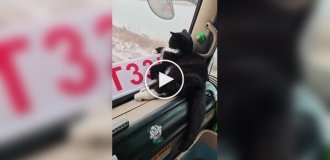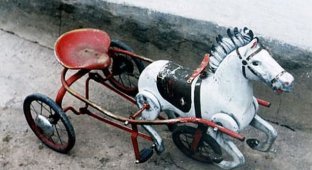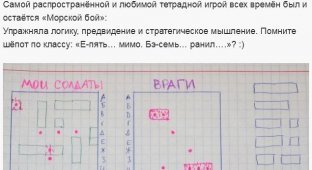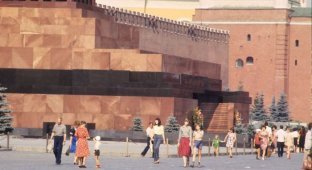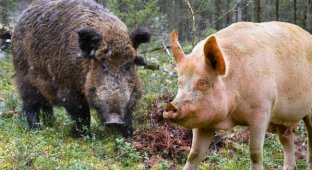What was in the arsenal of a Soviet child? The most common weapon was, of course, the slingshot. It’s hard to imagine a Soviet child who didn’t know what it was and didn’t shoot with it. Some by sparrows, some by bottles or cans, and some by glass or street lamps. The slingshot became widespread due to its simplicity of design, reliability higher than that of the AK-47, range and accuracy of combat, and, of course, lethal force. A properly made slingshot allowed a hundred meters of metal nut to break a window or street lamp. The cartridges could be anything - nuts, balls from bearings, smooth round stones, or more gentle cartridges - peas, rowan fruits, cherry pits...

The slingshot was taken from almost any tree, but the acacia slingshot was considered the best. Rubber was also used from various sources - bicycle inner tubes, medical tourniquet, wetsuit belts...

The slingshot had modifications for school paintball war games; during school breaks, small-caliber slingshots were used - a wire frame and a shock-return mechanism made of Hungarian elastic. Bent aluminum or copper wire was used as projectiles. Often, when playing war in the summer, a large piece of aluminum wire was simply wrapped around the belt two or three times and, if necessary, one could lie down behind a tree and quickly change the magazine to break the necessary ammunition.
This slingshot had a light version for school so that the teacher would not take the slingshot away. There was no slingshot as such - just an elastic band with pre-tied loops was put on the index and middle fingers. Dismantling weapons in case of danger took a split second...


A heavier version of the slingshot was the crossbow. A wooden clothespin was attached to the board, and an elastic band was attached to the other end in such a way that a “loop” was obtained, the saddle of which falls just on the clothespin. With the necessary stretching, of course. A “bullet” was placed in the elastic loop, the elastic was stretched and clamped into a clothespin. When the clothespin was pressed, a shot was fired. They shot with the same rowan berries, peas, peppercorns or pellets.

An example of such a crossbow.

Trigger

By the way, there was an “elite” variety of this type of weapon. Instead of a board, it used a slightly curved chair leg, similar to Pushkin’s dueling pistol, and an advanced wire trigger
The most advanced version was called self-propelled guns. This is closer to a real firearm. A thick-walled metal tube was sealed at one end (flattened and topped with lead), and a 1mm hole was drilled near the blind end. The pipe was attached to a wooden stock, usually in the shape of a pistol (again, sometimes the same chair leg was used). “Sulphur” from matches, a wad and a homemade sub-caliber lead bullet were driven into the tube using a ramrod. The shot was fired when a special striking frame, released by the trigger, struck the head of a nail inserted into a small hole.
The bullet had a very serious destructive force - 15 match heads in a 4mm barrel drove the bullet 5 centimeters into the tree. It would have been better not to end up with the police with a crossbow...

Another lightweight weapon was the match shooter. It was made from wooden clothespins. Do you feel the usefulness of this Soviet device? I shot with regular or burning matches at 10 meters.
To make it, a wooden clothespin was dismantled, a place for a spring (from the same clothespin) was sharpened with a file, a “trunk” was sharpened, a spring was put on one of the halves, the halves were connected with their reverse sides and rewound with electrical tape. The spring played the role of both the trigger and the pusher at the same time.
Sometimes a piece of “chirkash” from a matchbox was attached to the “trunk” so that the match would light itself at the moment of the shot. More often they simply passed the box over it and immediately shot.

In my childhood, explosive packages replaced modern firecrackers. There were a great many options for explosive mixtures, but in our yard they most often used a mixture of hydropyrite and analgin tablets, which could be bought at any pharmacy. I won’t tell you how to use it, because I don’t want it

My favorite ballistic weapon was “roof-to-ground” missiles made from saltpeter. More precisely, from newsprint soaked in a special mixture of saltpeter, sulfur and activated carbon, and then dried on a radiator. Scraps of this paper were tightly rolled into a tube, which was wrapped with foil on the outside. The appearance of the rocket was formed, a wick made of the same material as the filling was tightly inserted into the back part. To launch, you had to light the fuse and launch the rocket. The length of the wick determined when the ignition of its insides would begin and the rocket would fly with a howl, a whistle and scattered sparks. For this reason, it was best to launch them effectively from the roof of a high-rise building. You can recall many types of weapons that can be set on fire - smoke flares made from a plastic ruler or a piece of a tractor steering wheel, and grenades with nitro paint, and simple water bombs...
By the way, about water... Water was used in more harmless versions of children's weapons, as a rule, by younger schoolchildren. For example, in a regular spray bottle. A part of the body of a ballpoint pen was melted into a plastic bottle or simply inserted, and water was poured into the bottle. Then, by simply pressing the bottle, part of the water was squeezed out, which was directed by the “barrel” from the handle to the target. The disadvantages were the relatively short firing range and a drop in shot power when the water in the bottle was partially consumed. By the way, since we didn’t have the usual plastic bottles in our childhood, finding a good-quality body for a sprinkler was not so easy. We used bottles from "Quack-Quack" shampoo, PVA glue and liter bottles from "Belizna"

Another subspecies of light and more childish weapons were spitters. They spat through anything and everything - metal and plastic tubes, ballpoint pens and in general anything that had lengths and a cavity inside. Rolled pieces of paper, peppercorns, cherry pits, rowan berries and anything that had a round shape and could fly far were used as cartridges. Lovers of giving thrills made arrows for spitting balls - a ball was squeezed out of the paste rod of a ballpoint pen, and an ordinary sewing needle was driven into the rod itself. Such an “arrow” was inserted into a tube and blown into the target... I think it would be superfluous to talk about the sensations when the arrow hit the body...

In general, we teenagers frolicked to the fullest, staging real action on construction sites that a modern paintball schoolboy with all their armor and helmets could never even dream of...


